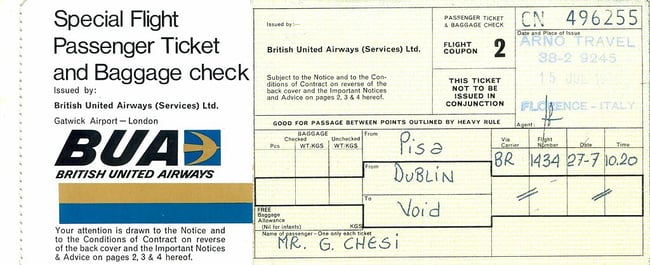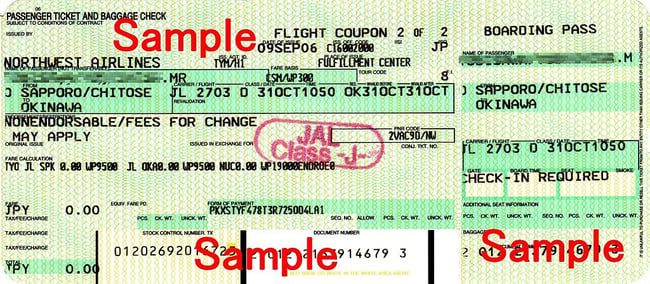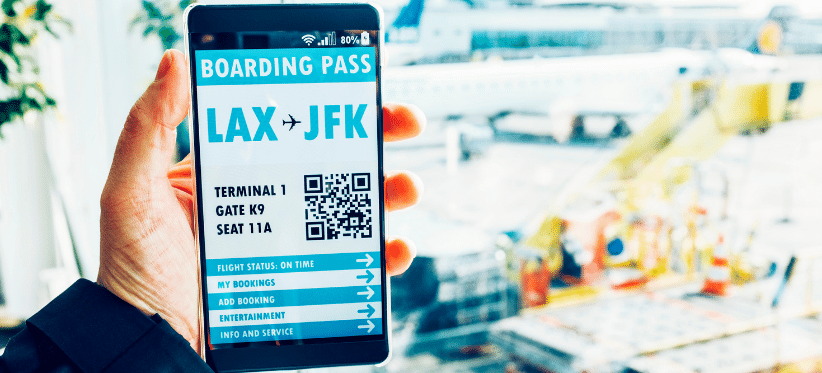It is the most important part of travel, but probably the only thing that you never take with you, any ideas?... It’s a ticket!
In a digital world where paper has been replaced by technology, it is hard to believe that less than 20 years ago you could not board a flight without a physical paper ticket. And less than 40 years ago nearly all tickets were manually written! Imagine that situation today, over 4.9 billion tickets, all with different handwriting, different codes and different flight numbers - huge potential for mistakes!
Paper Tickets and Carbonised Fingers
A few people may still remember paper tickets and more likely the red carbonised backs of those tickets that would smudge fingers, leave stains on clothing and most importantly for travellers with complex routings avoid the need for multiple tickets to be written. Indeed, in those regulated days booking a flight was so much more complex than today; schedules were published in large publications such as the OAG flight guides, fares were published in equally large books and most bookings required speaking to a travel agent who then called an airline. All that complexity finally resulted in a flight ticket being written and then couriered to the traveller; it all added up to the excitement of travel….it really was the “have ticket, can fly” era of travel.

British United Airways ticket issued on July 27, 1970 / Source: Wikimedia Commons
That era was also the time of “lose ticket and no travel”. Travelling around the world with a flimsy ticket issued on what felt like tracing paper sometimes stapled together with another ticket was a recipe for losing tickets. Sometimes those tickets would be scrunched up at the bottom of a briefcase and finally found after the bag’s contents had been emptied and the flight was about to close for departure. Many a sweaty traveller rushed through security with a paper ticket, boarding card with their seat number stapled to the documents and red fingers!
Nearly every airline, every travel agent and anyone involved in the airline industry would have a bookshelf full of reference books; the latest OAG flight guides, tariff books, visa and vaccine requirements and hotel guides. In the 1970’s OAG literally published thousands of monthly flight guides that were circulated around the world in a massive logistical exercise and with much of the typesetting still manual it was no surprise that OAG had as many skilled typesetters as many national newspapers!
Not surprisingly as aviation was growing rapidly and competition was increasing the days of paper tickets being issued were about to change, just in time to save millions of trees being chopped down.
Computers and Magnetic Stripes
In 1983 a new form of ticket was developed that complimented the development of major Computer Reservations Systems (CRS’s). The arrival of computers allowed airlines to start transforming their businesses, improving the efficiency of making a reservation and providing a central source where both schedules and air fares could be held in the same database and allow for both a reservation and ticket to be issued in one transaction, an incredible development! Of course, for many airlines the costs of such technology remained expensive and paper tickets continued to linger but for all airlines the writing was on the wall, electronic tickets were the way forward!
The breakthrough in these tickets, commonly known as ATB2 tickets was the magnetic stripe on the back of the ticket. All the data on the front of the ticket was also replicated on the back of the ticket in the magnetic stripe allowing for faster checking at airports, increased security levels and of course no red fingers. The introduction of CRS’s systems within airlines changed the industry forever; airfares began to change more frequently, schedules were adjusted on a monthly rather than bi-annual basis and airlines began to develop deeper commercial partnerships with other airlines as they shared systems and built connectivity. Before anyone could travel there was still a need to have a ticket in hand but the speed with which those tickets could be issued increased tenfold as the aviation industry adopted new travel technology.

Airline Ticket of Northwest Airlines / Source: Wikimedia Commons
The introduction of computerisation to the airline industry changed how OAG both received and distributed flight data. Rather than paper filings of schedules information being posted suddenly large magnetic tapes from airlines were arriving in the office which were then processed with OAG distributing consolidated schedules tapes to airlines and the then newly developing GDS’s. We still printed lots of flight guides and even produced timetables for airlines, but suddenly large boxes of magnetic tapes were being sent around the world on a weekly basis as the pace of change in the aviation industry accelerated.
A Seat But No Ticket
It took the airline industry nearly 60 years to move from handwritten tickets to electronic ticketing and then just ten years to ticketless travel. Not surprisingly a low-cost airline pioneered the concept; Southwest Airlines in 1994 issued the first E-ticket with IATA adopting a global standard for such tickets in 1997, although initial progress was slow with just 19% of all tickets “ticketless” by 2004, a slow adoption rate. Since that point in time, ticketless travel has become universal and very few airlines issue any form of paper ticket. Due to the advances made in travel technology, the industry is now completely computerised.
Ticketless travel has become a possibility for trips that involve changing from one airline to another. This requires only for the passengers to show up at the airport with a form of identification and hop on the plane. This development in ticketless travel represents another form of the improvements in travel technology, which has become popular and favoured by both airlines and travellers.
Travelling without a physical ticket is now universally accepted as the normal way to travel, was it ever different? Making a reservation for travel is now an everyday occurrence, and booking a flight is a five-minute transaction with the boarding card seat number being issued moments later and frequently all done on a mobile device!
The widespread adoption of ticketless travel, advances in travel technology and the internet distribution has decreased the need for complex and expensive ticketing systems used by airlines. Travel technology also reduces the industry’s costly dependence on travel agents to sell airline tickets. Moreover, the Internet as a primary medium for booking tickets has significantly increased the transparency involved in ticket pricing.
At OAG, we have constantly moved and changed as part of the industry to support every innovation, ticketless travel is just one of those examples. We still print reference books and schedule guides in some markets where communication can sometimes be variable or challenging but with nearly everything now digitised, we can receive a schedule change from an airline and distribute that back for sale in less than an hour. Now that is a huge change from 30 years ago!
Read next:
Predicting Travel Trends with Historical Flight Data – In Good Times and Bad
Finding New Air Service Opportunities – Four Best Practice Approaches



